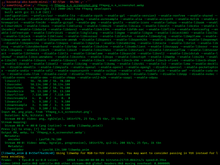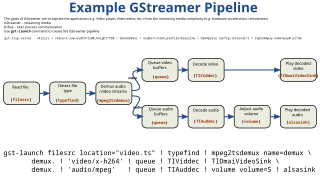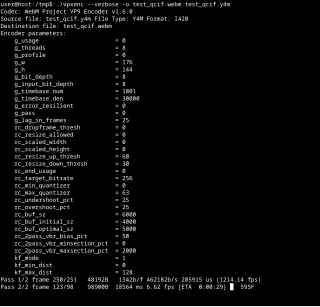| Group | Format type | Format name |
|---|
| ISO/IEC/ITU-T | Video | MPEG-1 Part 2, H.261 (Px64), [42] H.262/MPEG-2 Part 2, H.263, [42] MPEG-4 Part 2, H.264/MPEG-4 AVC, HEVC/H.265 [30] (MPEG-H Part 2), MPEG-4 VCB (a.k.a. VP8), Motion JPEG, IEC DV video and CD+G |
| Audio | MP1, MP2, MP3, AAC, HE-AAC, MPEG-4 ALS, G.711 μ-law, G.711 A-law, G.721 (a.k.a. G.726 32k), G.722, G.722.2 (a.k.a. AMR-WB), G.723 (a.k.a. G.726 24k and 40k), G.723.1, G.726, G.729, G.729D, IEC DV audio and Direct Stream Transfer |
| Subtitle | MPEG-4 Timed Text (a.k.a. 3GPP Timed Text) |
| Image | JPEG, Lossless JPEG, JPEG-LS, JPEG 2000, JPEG XL, [43] PNG, CCITT G3 and CCITT G4 |
| Alliance for Open Media | Video | AV1 [44] |
| Image | AVIF [45] |
| EIA | Subtitle | EIA-608 |
| CEA | Subtitle | CEA-708 |
| SMPTE | Video | SMPTE 314M (a.k.a. DVCAM and DVCPRO), SMPTE 370M (a.k.a. DVCPRO HD), VC-1 (a.k.a. WMV3), VC-2 (a.k.a. Dirac Pro), VC-3 (a.k.a. AVID DNxHD) |
| Audio | SMPTE 302M |
| Image | DPX |
| ATSC/ETSI/DVB | Audio | Full Rate (GSM 06.10), AC-3 (Dolby Digital), Enhanced AC-3 (Dolby Digital Plus) and DTS Coherent Acoustics (a.k.a. DTS or DCA) |
| Subtitle | DVB Subtitling (ETSI 300 743) |
| DVD Forum/Dolby | Audio | MLP / Dolby TrueHD |
| Subtitle | DVD-Video subtitles |
| Xperi/DTS, Inc/QDesign | Audio | DTS Coherent Acoustics (a.k.a. DTS or DCA), DTS Extended Surround (a.k.a. DTS-ES), DTS 96/24, DTS-HD High Resolution Audio, DTS Express (a.k.a. DTS-HD LBR), DTS-HD Master Audio, QDesign Music Codec 1 and 2 |
| Blu-ray Disc Association | Subtitle | PGS (Presentation Graphics Stream) |
| 3GPP | Audio | AMR-NB, AMR-WB (a.k.a. G.722.2) |
| 3GPP2 | Audio | QCELP-8 (a.k.a. SmartRate or IS-96C), QCELP-13 (a.k.a. PureVoice or IS-733) and Enhanced Variable Rate Codec (EVRC. a.k.a. IS-127) |
| World Wide Web Consortium | Video | Animated GIF [46] |
| Subtitle | WebVTT |
| Image | GIF, and SVG (via librsvg) |
| IETF | Video | FFV1 |
| Audio | iLBC (via libilbc), Opus and Comfort noise |
| International Voice Association | Audio | DSS-SP |
| SAC | Video | AVS video, AVS2 video [47] (via libdavs2), and AVS3 video (via libuavs3d) |
| Microsoft | Video | Microsoft RLE, Microsoft Video 1, Cinepak, Microsoft MPEG-4 v1, v2 and v3, Windows Media Video (WMV1, WMV2, WMV3/VC-1), WMV Screen and Mimic codec |
| Audio | Windows Media Audio (WMA1, WMA2, WMA Pro and WMA Lossless), XMA (XMA1 and XMA2), [48] MSN Siren, MS-GSM and MS-ADPCM |
| Subtitle | SAMI |
| Image | Windows Bitmap, WMV Image (WMV9 Image and WMV9 Image v2), DirectDraw Surface, and MSP [49] |
| Interactive Multimedia Association | Audio | IMA ADPCM |
| Intel / Digital Video Interactive | Video | RTV 2.1 (Indeo 2), Indeo 3, 4 and 5, [42] and Intel H.263 |
| Audio | DVI4 (a.k.a. IMA DVI ADPCM), Intel Music Coder, and Indeo Audio Coder |
| RealNetworks | Video | RealVideo Fractal Codec (a.k.a. Iterated Systems ClearVideo), 1, 2, 3 and 4 |
| Audio | RealAudio v1 – v10, and RealAudio Lossless [50] |
| Subtitle | RealText |
| Apple / Spruce Technologies | Video | Cinepak (Apple Compact Video), ProRes, Sorenson 3 Codec, QuickTime Animation (Apple Animation), QuickTime Graphics (Apple Graphics), Apple Video, Apple Intermediate Codec and Pixlet [51] |
| Audio | ALAC |
| Image | QuickDraw PICT |
| Subtitle | Spruce subtitle (STL) |
| Adobe Flash Player (SWF) | Video | Screen video, Screen video 2, Sorenson Spark and VP6 |
| Audio | Adobe SWF ADPCM and Nellymoser Asao |
| Adobe / Aldus | Image | TIFF, PSD, [51] and DNG |
| Xiph.Org | Video | Theora |
| Audio | Speex, [52] Vorbis, Opus and FLAC |
| Subtitle | Ogg Writ |
| Sony | Audio | Adaptive Transform Acoustic Coding (ATRAC1, ATRAC3, ATRAC3Plus, [53] and ATRAC9 [47] ) [42] and PSX ADPCM |
| NTT | Audio | TwinVQ |
| Google / On2 / GIPS | Video | Duck TrueMotion 1, Duck TrueMotion 2, Duck TrueMotion 2.0 Real Time, VP3, VP4, [54] VP5, [42] VP6, [42] VP7, VP8, [55] VP9 [29] and animated WebP |
| Audio | DK ADPCM Audio 3/4, On2 AVC and iLBC (via libilbc) |
| Image | WebP [56] |
| Epic Games / RAD Game Tools | Video | Smacker video and Bink video |
| Audio | Bink audio |
| CRI Middleware | Audio | ADX ADPCM, and HCA |
| Nintendo / NERD | Video | Mobiclip video |
| Audio | GCADPCM (a.k.a. ADPCM THP), FastAudio, and ADPCM IMA MOFLEX |
| Synaptics / DSP Group | Audio | Truespeech |
| Electronic Arts / Criterion Games / Black Box Games / Westwood Studios | Video | RenderWare TXD, [57] Madcow, CMV, TGV, TGQ, TQI, Midivid VQ (MVDV), MidiVid 3.0 (MV30), Midivid Archival (MVHA), and Vector Quantized Animation (VQA) |
| Audio | Electronic Arts ADPCM variants |
| Netpbm | Image | PBM, PGM, PPM, PNM, PAM, PFM and PHM |
| MIT/X Consortium/The Open Group | Image | XBM, [50] XPM and xwd |
| HPE / SGI / Silicon Graphics | Video | Silicon Graphics RLE 8-bit video, [46] Silicon Graphics MVC1/2 [46] |
| Image | Silicon Graphics Image |
| Oracle/Sun Microsystems | Image | Sun Raster |
| IBM | Video | IBM UltiMotion |
| Avid Technology / Truevision | Video | Avid 1:1x, Avid Meridien, [50] Avid DNxHD, Avid DNx444, [53] and DNxHR |
| Image | Targa [46] |
| Autodesk / Alias | Video | Autodesk Animator Studio Codec and FLIC |
| Image | Alias PIX |
| Activision Blizzard / Activision / Infocom | Audio | ADPCM Zork |
| Konami / Hudson Soft | Video | HVQM4 Video |
| Audio | Konami MTAF, and ADPCM IMA HVQM4 |
| Grass Valley / Canopus | Video | HQ, HQA, HQX and Lossless |
| Vizrt / NewTek | Video | SpeedHQ |
| Image | Vizrt Binary Image [45] |
| Academy Software Foundation / ILM | Image | OpenEXR [50] |
| Mozilla Corporation | Video | APNG [56] |
| Matrox | Video | Matrox Uncompressed SD (M101) / HD (M102) |
| AMD/ATI | Video | ATI VCR1/VCR2 |
| Asus | Video | ASUS V1/V2 codec |
| Commodore | Video | CDXL codec |
| Kodak | Image | Photo CD |
| Blackmagic Design / Cintel | Image | Cintel RAW |
| Houghton Mifflin Harcourt / The Learning Company / ZSoft Corporation | Image | PCX |
| Australian National University | Image | X-Face [46] |
| Bluetooth Special Interest Group | Audio | SBC, and mSBC |
| Qualcomm / CSR | Audio | QCELP, aptX, and aptX HD |
| Open Mobile Alliance / WAP Forum | Image | Wireless Bitmap |









